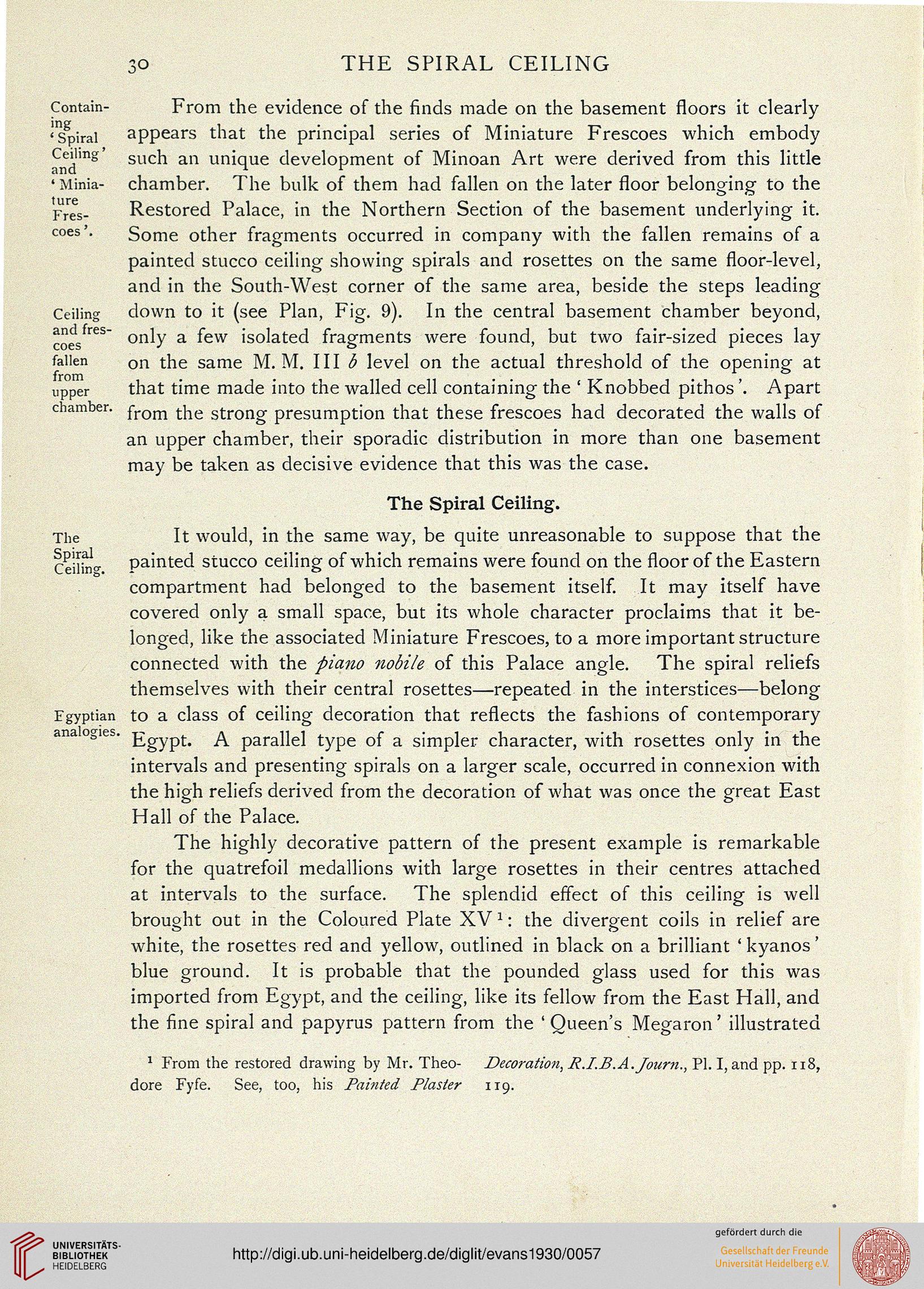THE SPIRAL CEILING
Contain-
ing
* Spiral
Ceiling'
and
' Minia-
ture
Fres-
coes '.
Ceiling
and fres-
coes
fallen
from
upper
chamber.
The
Spiral
Ceiling.
Egyptian
analogies.
From the evidence of the finds made on the basement floors it clearly
appears that the principal series of Miniature Frescoes which embody
such an unique development of Minoan Art were derived from this little
chamber. The bulk of them had fallen on the later floor belonging to the
Restored Palace, in the Northern Section of the basement underlying it.
Some other fragments occurred in company with the fallen remains of a
painted stucco ceiling showing spirals and rosettes on the same floor-level,
and in the South-West corner of the same area, beside the steps leading
down to it (see Plan, Fig. 9). In the central basement chamber beyond,
only a few isolated fragments were found, but two fair-sized pieces lay
on the same M. M. Ill b level on the actual threshold of the opening at
that time made into the walled cell containing the ' Knobbed pithos '. Apart
from the strong presumption that these frescoes had decorated the walls of
an upper chamber, their sporadic distribution in more than one basement
may be taken as decisive evidence that this was the case.
The Spiral Ceiling.
It would, in the same way, be quite unreasonable to suppose that the
painted stucco ceiling of which remains were found on the floor of the Eastern
compartment had belonged to the basement itself. It may itself have
covered only a small space, but its whole character proclaims that it be-
longed, like the associated Miniature Frescoes, to a more important structure
connected with the piano nobile of this Palace angle. The spiral reliefs
themselves with their central rosettes—repeated in the interstices—belong
to a class of ceiling decoration that reflects the fashions of contemporary
Egypt. A parallel type of a simpler character, with rosettes only in the
intervals and presenting spirals on a larger scale, occurred in connexion with
the high reliefs derived from the decoration of what was once the great East
Hall of the Palace.
The highly decorative pattern of the present example is remarkable
for the quatrefoil medallions with large rosettes in their centres attached
at intervals to the surface. The splendid effect of this ceiling is well
brought out in the Coloured Plate XV x: the divergent coils in relief are
white, the rosettes red and yellow, outlined in black on a brilliant ' kyanos'
blue ground. It is probable that the pounded glass used for this was
imported from Egypt, and the ceiling, like its fellow from the East Hall, and
the fine spiral and papyrus pattern from the ' Queen's Megaron' illustrated
1 From the restored drawing by Mr. Theo- Decoration, R.I.B.A.Journ., PI. I, and pp. 118,
dore Fyfe. See, too, his Painted Plaster 119.
Contain-
ing
* Spiral
Ceiling'
and
' Minia-
ture
Fres-
coes '.
Ceiling
and fres-
coes
fallen
from
upper
chamber.
The
Spiral
Ceiling.
Egyptian
analogies.
From the evidence of the finds made on the basement floors it clearly
appears that the principal series of Miniature Frescoes which embody
such an unique development of Minoan Art were derived from this little
chamber. The bulk of them had fallen on the later floor belonging to the
Restored Palace, in the Northern Section of the basement underlying it.
Some other fragments occurred in company with the fallen remains of a
painted stucco ceiling showing spirals and rosettes on the same floor-level,
and in the South-West corner of the same area, beside the steps leading
down to it (see Plan, Fig. 9). In the central basement chamber beyond,
only a few isolated fragments were found, but two fair-sized pieces lay
on the same M. M. Ill b level on the actual threshold of the opening at
that time made into the walled cell containing the ' Knobbed pithos '. Apart
from the strong presumption that these frescoes had decorated the walls of
an upper chamber, their sporadic distribution in more than one basement
may be taken as decisive evidence that this was the case.
The Spiral Ceiling.
It would, in the same way, be quite unreasonable to suppose that the
painted stucco ceiling of which remains were found on the floor of the Eastern
compartment had belonged to the basement itself. It may itself have
covered only a small space, but its whole character proclaims that it be-
longed, like the associated Miniature Frescoes, to a more important structure
connected with the piano nobile of this Palace angle. The spiral reliefs
themselves with their central rosettes—repeated in the interstices—belong
to a class of ceiling decoration that reflects the fashions of contemporary
Egypt. A parallel type of a simpler character, with rosettes only in the
intervals and presenting spirals on a larger scale, occurred in connexion with
the high reliefs derived from the decoration of what was once the great East
Hall of the Palace.
The highly decorative pattern of the present example is remarkable
for the quatrefoil medallions with large rosettes in their centres attached
at intervals to the surface. The splendid effect of this ceiling is well
brought out in the Coloured Plate XV x: the divergent coils in relief are
white, the rosettes red and yellow, outlined in black on a brilliant ' kyanos'
blue ground. It is probable that the pounded glass used for this was
imported from Egypt, and the ceiling, like its fellow from the East Hall, and
the fine spiral and papyrus pattern from the ' Queen's Megaron' illustrated
1 From the restored drawing by Mr. Theo- Decoration, R.I.B.A.Journ., PI. I, and pp. 118,
dore Fyfe. See, too, his Painted Plaster 119.





